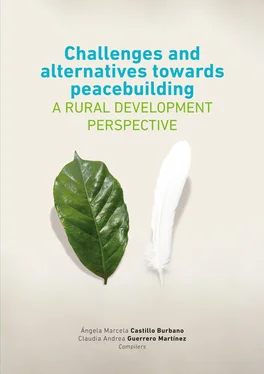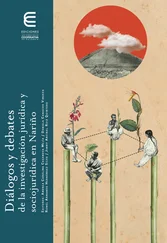1The word “campesino” is used in the Colombian context to describe the rural population who work the land (including their families); land which they rarely own. The closest interpretation for the word is “peasant” but, given its loose and sometimes derogatory application, the word campesino will continue to be used in this book.
| how to cite this chapterRiascos Mora, A., & Ortega Salas, A. L. (2020). Dinámica del conflicto y del posacuerdo en territorio nariñense. In Á. M. Castillo Burbano & C. A. Guerrero Martínez (comps.), Challenges and alternatives towards peacebuilding: a rural development perspective (Philippe White, Transl.) (pp. 55-66). Bogota: Ediciones UCC & Centro Editorial Uniminuto. (Original title published in 2019). https://dx.doi.org/10.16925/9789587602388 |
Chapter II
Dynamics of conflict and post-agreement in the Nariñense territory
Amanda Janneth Riascos Mora, Alba Lucy Ortega Salas
Abstract
To build peace, it is important to understand the previous dynamics of the conflict in Colombia, to know the main agreements between the armed group of the Armed Forces and Revolutionaries of Colombia, FARC, and the National Government, and finally, to analyze the post-agreement phase. For this, it is important to theoretically approach the concept of conflict and the different forms of negotiation, and thus, provide the reader with a proper perspective of the post-agreement period in the Nariñense territory.
Keywords: territory, conflict, peace, Nariño.
Resumen
Para construir la paz, es importante comprender cuál ha sido la dinámica del conflicto en Colombia, conocer los principales acuerdos entre el grupo armado Fuerzas Armadas y Revolucionarias de Colombia, FARC, y el Gobierno Nacional, para finalmente, analizar la fase del posacuerdo. Para ello es importante acercarse teóricamente al concepto de conflicto y las formas de negociación, y así, mostrar al lector una mirada real del posacuerdo en el territorio nariñense.
Palabras clave: territorio, conflicto, paz, Nariño.
Introduction
According to the Nariño Peace Agenda 2013-2015 (United Nations Development Program – UNDP, 2016), it is stated that “The department of Nariño has been one of the most affected by the armed conflict that has ravaged Colombia for decades; more than 400,000 victims, the highest national rate of illicit crop cultivation, among other aspects, make peace not only an option, but a necessity for the people of Nariño” (p. 7). However, after the negotiation of the armed conflict with the FARC-EP, Colombia has set off down a path towards peace that must be built from within the territories. In this sense, it is important that the reality of the post-agreement in the Nariñense territory be understood, allowing for the generation of strategies that lead to the materialization of peace agreements and the true construction of peaceful scenarios.
In order to choose effective and appropriate ways to transform the conflict, it is important to first understand the nature of the conflict in general terms, and then to find ways to identify the particular characteristics of specific conflicts. In this sense, Estanislao Zuleta (2015) in the document “On war”, states:
To fight the war with a remote but real chance of success, it is necessary to begin by recognizing that conflict and hostility are constitutive phenomena of the social bond, such as interdependence itself, and that the notion of a harmonious society is a contradiction in terms. The eradication of conflicts and their dissolution into a warm coexistence is neither an attainable nor desirable goal; neither in personal life –in love and friendship– nor in collective life. On the contrary, it is necessary to build a social and legal space in which conflicts can manifest and develop, without the ‘opposition to the other’ leading to the ‘suppression of the other’; killing him, reducing him to impotence or silencing him.
In this way, the dynamics of post-conflict and post-agreement in the Nariño territory have been proposed with a positive outlook on the conflict, understood from a real environment, capable of producing personal, social and political changes.
The dynamics within the territory
When analyzing the Colombian conflict, it is important to clearly define the situation so as to subsequently help reach a post-agreement period through negotiation, thereby allowing for a true analysis of the reality of the post-agreement in the territory of Nariño.
If we understand the conflict as a difference between two parties or more (Lederach, 1990; Rios, 1997, cited by Tejada, 2008) and that this difference occurs in particular contexts and situations and involves people with their own individual stories, we can understand both the dynamics of the conflict and its solution. Seen from this perspective, conflict is a complex process that implies clearly definable and objective aspects, imbued with a number of subjective aspects, which are often not expressed, are not recognized and, lesser still, perceived as part of the conflict.
Alonso Tejada Zabaleta (2008) mentions that, over the last few years of the conflict resolution process,
the views that one has, socially speaking, on the processes of detection, management and conflict resolution, have changed. First, it is increasingly clear that conflict itself is not negative; in fact, theories that hold the view that conflict is a fundamental part of human nature and that it fundamentally collaborates in its development, are receiving increasing support. The problem, therefore, does not seem to lie in the conflict itself but in the way that it is addressed and resolved.
Particularly in a medium like Colombia, where there is a cultural indoctrination of resolving conflict in a violent and hostile way, without recognizing fundamental human values and significant and positive moral forms, and forgetting assertive forms of solution, it becomes more palpable to train the community in prosocial conflict resolution alternatives.
The problem seems to lie in the conflict resolution methodologies. There are still sectors of educators and institutions in charge of facing the problem, who think that the forming and training of communities should be based on visual and verbal campaigns; these ultimately stereotype the problems and have no real effect.
It seems that the solution to this depends on a complex and integrated process, allowing for real changes to be generated. First, is to accept that one must think in terms of systematic processes (massive, punctual, very short duration campaigns have not shown significant changes); Second, the processes must be directed at people and not at the masses. Third, training must be experiential, continuous, directed, monitored and fed back in such a way that changes can be made in an explicit, adaptive and strengthening way.
In this sense, it can be said that the problem of the conflict in Colombia is not the conflict itself; both legal and illegal groups have apparently laudable interests and ends. However, these interests were not initially resolved by peaceful means and led to violent actions consolidated in history as an armed conflict. This situation has formed implicit cultural tendencies, transmitted from generation to generation, where the conflict itself leads to thoughts of violence and war.
When analyzing the issue of conflict in the department of Nariño, it is important to note that Nariño is located in the south of the country, featuring fertile lands, its characteristic patchwork tapestry of fields, land strategically located on the equator that guarantees a variety of climates with its mountains, coast and Amazonia. It is possible that due to its distance from the center of the country, it has remained one of the most neglected departments by the National Government. The additional factor, of Nariño lying on the border of the country, only serves to exacerbate socio-economic problems and facilitate others such as drug trafficking.
Читать дальше












